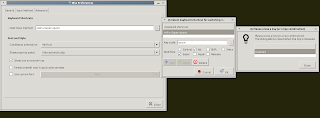RDP is more efficient and has better performing than VNC and probably is more secure.
Installation
The adventage of x11vnc is that you have the same desktop that is open in your workstation and two persons can share the screen. The cons is that you need to have a logged user in the Xs before using it. If you restart the
machine then you need to do some tricks to us x11vnc as root to be able
to go to the splash window.
XRDP is better but by default you open different sessions each time and is not trivial how to get the current session active in your workstation.
Anyway, if you use Centos7 you will have probles usig XRDP because there are some issues with selenux (the security system for applications in redhat)
XRDP can be installed from EPEL repo (the essential extra packages).
# install EPEL repo
$ sudo yum install epel-release
$ sudo yum update
# install XRDP
$ sudo yum install xrdp tigervnc-server
$ sudo service xrdp start
$ sudo service xrdp-sesman start
After installing, activate the service
$ sudo systemctl enable xrdp.service
Confirm that XRDP is runing
# netstat -antup | grep xrdp
tcp 0 0 0.0.0.0:3389 0.0.0.0:* LISTEN 1508/xrdp
tcp 0 0 127.0.0.1:3350 0.0.0.0:* LISTEN 1507/xrdp-sesman
But the job is not finished. By default XRDP listen to 3389 but this service is not allowed to listen to this port by default. You need to fix security and firewall to allow XRDP listen to 3389 (selenux) and allow external connections to 2289 (firewall)
# allow selemux (use one of the two options. Option 2 is prefered)
## option 1
$ sudo chcon --type=bin_t /usr/sbin/xrdp
$ sudo chcon --type=bin_t /usr/sbin/xrdp-sesman
## option 2
$ sudo semanage fcontext -a -t bin_t /usr/sbin/xrdp
$ sudo semanage fcontext -a -t bin_t /usr/sbin/xrdp-sesman
$ sudo restorecon -v /usr/sbin/xrdp*
# using chcon updates the SELinux context temporarily until the next relabelling.
# A permanent method is to use semanage and restorecon
# allow firewall for external connections (just in case is not open by default)
$ sudo firewall-cmd --permanent --zone=public --add-port=3389/tcp
$ sudo firewall-cmd --reload
Configuration
The config file is in
/etc/xrdp/xrdp.ini
The port by default is 3389 and you can change here:
[globals]
# xrdp.ini file version number
ini_version=1
bitmap_cache=yes
bitmap_compression=yes
port=3389
And the setting for reconnecting to the previous session is in section "[XRDP1]" for port attribute. Set to ask-1
[xrdp1]
name=sesman-Xvnc
lib=libvnc.so
username=ask
password=ask
ip=127.0.0.1
port=ask-1
delay_ms=2000
ask would ask you for a port in the log in. If no port given, with the
-1 a new one is assigned
If you can remember the current port for your session see next section
How to find the current XRDP session port
You could login a ssh session and find out the number by
netstat -tulpn | grep vnc
and you will get something like the following
tcp 0 0 127.0.0.1:5910 0.0.0.0:* LISTEN 5365/Xvnc
and then you know 5910 was the port you connected to.
More infor about XRDP and X11vnc and vnc links can be found at http://c-nergy.be/blog/?p=6063






























